Disc jockey
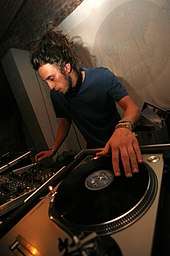
A disc jockey, often abbreviated as DJ, is a person who plays existing recorded music for a live audience. Most common types of DJs include radio DJ, club DJ who performs at a nightclub or music festival and turntablist who uses record players, usually turntables, to manipulate sounds on phonograph records. Originally, the disc in disc jockey referred to gramophone records, but now DJ is used as an all-encompassing term to describe someone who mixes recorded music from any source, including cassettes, CDs or digital audio files on a CDJ or laptop. The title DJ is commonly used by DJs in front of their real names or adopted pseudonyms or stage names.
DJs use equipment that can play at least two sources of recorded music simultaneously and mix them together to create seamless transitions between recordings and develop unique mixes of songs. Often, this involves aligning the beats of the music sources so their rhythms do not clash when played together or to enable a smooth transition from one song to another. DJs often use specialized DJ mixers, small audio mixers with crossfader and cue functions to blend or transition from one song to another. Mixers are also used to pre-listen to sources of recorded music in headphones and adjust upcoming tracks to mix with currently playing music. DJ software can be used with a DJ controller device to mix audio files on a computer instead of a console mixer. DJs may also use a microphone to speak to the audience; effects units such as reverb to create sound effects and electronic musical instruments such as drum machines and synthesizers.
Description
Originally, the "disc" in "disc jockey" referred to gramophone records, but now "DJ" is used as an all-encompassing term to describe someone who mixes recorded music from any source, including vinyl records, cassettes, CDs, or digital audio files stored on USB stick or laptop. DJs typically perform for a live audience in a nightclub or dance club or a TV, radio broadcast audience, or in the 2010s, an online radio audience. DJs also create mixes, remixes and tracks that are recorded for later sale and distribution. In hip hop music, DJs may create beats, using percussion breaks, basslines and other musical content sampled from pre-existing records. In hip hop, rappers and MCs use these beats to rap over.
DJs use equipment that can play at least two sources of recorded music simultaneously and mix them together. This allows the DJ to create seamless transitions between recordings and develop unique mixes of songs. Often, this involves aligning the beats of the music sources so their rhythms do not clash when they are played together, either so two records can be played at the same time, or to enable the DJ to make a smooth transition from one song to another. An important tool for DJs is the specialized DJ mixer, a small audio mixer with a crossfader and cue functions. The crossfader enables the DJ to blend or transition from one song to another. The cue knobs or switches allow the DJ to listen to a source of recorded music in headphones before playing it for the live club or broadcast audience. Previewing the music in headphones helps the DJ pick the next track they want to play, cue up the track to the desired starting location, and align the two tracks' beats in traditional situations where auto sync technology is not being used. This process ensures that the selected song will mix well with the currently playing music. DJs may also use a microphone to speak to the audience; effects units such as reverb to create sound effects; and electronic musical instruments such as drum machines and synthesizers.
The title "DJ" is also commonly used by DJs in front of their real names or adopted pseudonyms or stage names as a title to denote their profession (e.g., DJ Jazzy Jeff, DJ Q-bert, DJ Shadow and DJ Yoda). Some DJs focus on creating a good mix of songs for the club dancers or radio audience. Other DJs use turntablism techniques such as "scratching", in which the DJ or turntablist manipulates the record player turntable to create new rhythms and sounds. DJs need to have a mixture of artistic and technical skills for their profession, because they have to understand both the creative aspects of making new musical beats and tracks, and the technical aspects of using audio consoles, professional audio equipment, and, in the 2010s, Digital Audio Workstations and other computerized music gear. In many types of DJing, including club DJing and radio/TV DJing, a DJ also has to have charisma and develop a good rapport with the audience. Professional DJs often specialize in a specific genre of music, such as house music or hip hop music. DJs typically have an extensive knowledge about the music they specialize in. Many DJs are avid music collectors of vintage, rare or obscure tracks and records.
Types
Radio DJs
Radio DJs or radio personalities introduce and play music that is broadcast on AM, FM, digital or Internet radio stations.
Club DJs
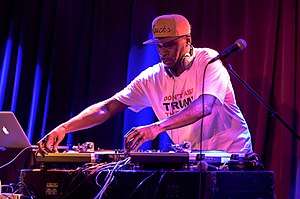
Club DJs, commonly referred as DJs in general, play music at musical events, such as parties at music venues or bars, music festivals, corporate and private events. Typically, club DJs mix music recordings from two or more sources using different mixing techniques in order to produce non-stopping flow of music. One key technique used for seamlessly transitioning from one song to another is beatmatching. A genre of recordings DJ plays defines a genre of such DJ, for example, you can often see terms like Hip Hop DJ, House DJ, Techno DJ etc. The quality of a DJ performance (often called a DJ mix or DJ set) consists of two main features: technical skills, or how well can DJ operate the equipment and produce smooth transitions between two or more recordings and a playlist, or ability of a DJ to select most suitable recordings also known as "reading the crowd".[1]
Turntablists
Turntablists, also called battle DJs, use turntables and DJ mixer to manipulate recorded sounds in order to produce new music. In essence, they use DJ equipment as a musical instrument. The most known turntablist technique is scratching. Turntablists often participate in DJ contests like DMC World DJ Championships and Red Bull 3Style.[2]
Residents
A resident DJ performs at a venue on a regular basis or permanently.[3][4][5] They would perform regularly (typically under an agreement) in a particular discotheque, a particular club, a particular event, or a particular broadcasting station.[6][7][8] Residents have a decisive influence on the club or a series of events.[9] Per agreement with the management or company, the DJ would have to perform under agreed times and dates.[4][10] Typically, DJs perform as residents for two or three times in a week, for example, on Friday and Saturday. Also, DJs who make a steady income from a venue, are also considered resident DJs.[11][12] Wynn Nightlife and Hakkasan are well known for hiring high-profile DJs as residents with 'skyrocketing pay'.[13]
Notable resident DJs[14][15] include:
- Richie Hawtin - Amnesia, Ibiza
- Larry Levan - Paradise Garage, New York City
- Alfredo Fiorito - Amnesia, Ibiza
- Tama Sumo - Panorama Bar, Berlin
- David Mancuso - The Loft, New York
- Fish Go Deep - Cork, Ireland
- Tiësto - Hakkasan, Las Vegas
- Avicii - Encore Beach Club, Las Vegas
- Deadmau5 - Hakkasan, Las Vegas
- Calvin Harris - Hakkasan, Las Vegas
- Kaskade - Encore Beach Club, Las Vegas
- Skrillex - Mandalay Bay, Las Vegas
- Martin Garrix - Hï Ibiza
Deejays (in reggae)
In Jamaican music, a deejay (DJ) is a reggae or dance-hall musician who sings and raps ("toasts") to an instrumental riddim.
Other types
- Mobile DJs - DJs with their own portable audio sound systems who specialize in performing at gatherings such as block parties, street fairs, taverns, weddings, birthdays, school and corporate events. Mobile DJs may also offer lighting packages and video systems.[16]
- DJanes - a term describing female DJs used in countries such as Germany that employ grammatical gender in their languages.[17]
- Celebrity DJs - widely known celebrities performing as DJs.[18]
- Bedroom DJs - a general term for DJs performing at home, usually recording their sets and posting them online.[19]
Equipment
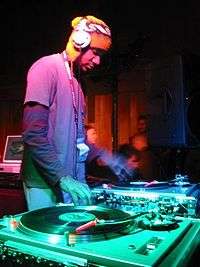
As music technology has progressed, DJs have adopted different types of equipment to play and mix music, all of which are still commonly used. Traditionally, DJs used two turntables plugged into a DJ mixer to mix music on vinyl records. As compact discs became popular media for publishing music, specialized high quality CD players known as CDJs were developed for DJs. CDJs can take the place of turntables or be used together with turntables. Many CDJs can now play digital music files from USB flash drives or SD cards in addition to CDs. With the spread of portable laptop, tablet, and smartphone computers, DJs began using software together with specialized sound cards and DJ controller hardware. DJ software can be used in conjunction with a hardware DJ mixer or be used instead of a hardware mixer.
Turntables
Turntables allow DJs to play vinyl records. By adjusting the playback speed of the turntable, either by adjusting the speed knob, or by manipulating the platter (e.g., by slowing down the platter by putting a finger gently along the side), DJs can match the tempos of different records so their rhythms can be played together at the same time without clashing or make a smooth, seamless transition from one song to another. This technique is known as beatmatching. DJs typically replace the rubber mat on turntables that keeps the record moving in sync with the turntable with a slipmat that facilitates manipulating the playback of the record by hand. With the slipmat, the DJ can stop or slow down the record while the turntable is still spinning. Direct-drive turntables are the type preferred by DJs, with the Technics SL-1200 being the most popular model of turntables for DJs. Belt-drive turntables are less expensive, but they are not suitable for turntablism and DJing, because the belt-drive motor does not like being slowed down, as it can stretch out the belt. Some DJs, most commonly those who play hip hop music, go beyond merely mixing records and use turntables as musical instruments for scratching, beat juggling, and other turntablism techniques.
CDJs
CDJs are high quality digital media players made for DJing. They often have large jog wheels and pitch controls to allow DJs to manipulate the playback of digital files for beatmatching similar to how DJs manipulate vinyl records on turntables. CDJs often have features such as loops and waveform displays similar to DJ software. Originally designed to play music from compact discs, they now can play digital music files stored on USB flash drives and SD cards. Some CDJs can also connect to a computer running DJ software to act as a DJ controller.
DJ mixers
DJ mixers are small audio mixing consoles specialized for DJing. Most DJ mixers have far fewer channels than a mixer used by a record producer or audio engineer; whereas standard live sound mixers in small venues have 12 to 24 channels, and standard recording studio mixers have even more (as many as 72 on large boards), basic DJ mixers may have only two channels. While DJ mixers have many of the same features found on larger mixers (faders, equalization knobs, gain knobs, effects units, etc.), DJ mixers have a feature that is usually only found on DJ mixers: the crossfader. The crossfader is a type of fader that is mounted horizontally. DJs used the crossfader to mix two or more sound sources. The midpoint of the crossfader's travel is a 50/50 mix of the two channels (on a two channel mixer). The far left side of the crossfader provides only the channel A sound source. The far right side provides only the channel B sound source (e.g., record player number 2). Positions in between the two extremes provide different mixes of the two channels. Some DJs use a computer with DJ software and a DJ controller instead of an analog DJ mixer to mix music, although DJ software can be used in conjunction with a hardware DJ mixer.
Headphones
DJs generally use higher quality headphones than those designed for music consumers. DJ headphones have other properties useful for DJs, such as designs that acoustically isolate the sounds of the headphones from the outside environment (hard shell headphones), flexible headbands and pivot joints to allow DJs to listen to one side of the headphones, while turning the other headphone away (so he/she can monitor the mix in the club), and replaceable cables. Replaceable cables enables DJs to buy new cables if a cable becomes frayed, worn, or damaged, or if a cable is accidentally cut.
Closed-back headphones are highly recommended for DJs to block outside noise as the environment of DJ usually tend to be very noisy. Standard headphones have 3.5mm jack but DJ equipment usually requires ¼ inch jack. Most of specialized DJ Headphones have an adapter to switch between 3.5mm jack and ¼ inch jack. Detachable coiled cables are perfect for DJ Headphones.[20]
Software
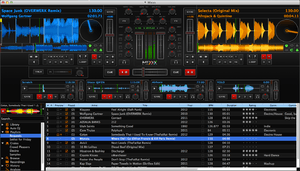
DJs have changed their equipment as new technologies are introduced. The earliest DJs in pop music, in 1970s discos, used record turntables, vinyl records and audio consoles. In the 1970s, DJs would have to lug heavy direct drive turntables and crates of records to clubs and shows. In the 1980s, many DJs transitioned to compact cassettes. In the 1990s and 2000s, many DJs switched to using digital audio such as CDs and MP3 files. As technological advances made it practical to store large collections of digital music files on a laptop computer, DJ software was developed so DJs could use a laptop as a source of music instead of transporting CDs or vinyl records to gigs. Unlike most music player software designed for regular consumers, DJ software can play at least two audio files simultaneously, display the waveforms of the files on screen and enable the DJ to listen to either source.
The waveforms allow the DJ see what is coming next in the music and how the playback of different files is aligned. The software analyzes music files to identify their tempo and where the beats are. The analyzed information can be used by the DJ to help manually beatmatch like with vinyl records or the software can automatically synchronize the beats. Digital signal processing algorithms in software allow DJs to adjust the tempo of recordings independently of their pitch (and musical key, a feature known as "keylock". Some software analyzes the loudness of the music for automatic normalization with ReplayGain and detects the musical key. Additionally, DJ software can store cue points, set loops, and apply effects.
As tablet computers and smartphones became widespread, DJ software was written to run on these devices in addition to laptops. DJ software requires specialized hardware in addition to a computer to fully take advantage of its features. The consumer grade, regular sound card integrated into most computer motherboards can only output two channels (one stereo pair). However, DJs need to be able to output at least four channels (two stereo pairs, thus Left and Right for input 1 and Left and Right for input 2), either unmixed signals to send to a DJ mixer or a main output plus a headphone output. Additionally, DJ sound cards output higher quality signals than the sound cards built into consumer-grade computer motherboards.
Timecode
Special vinyl records (or CDs/digital files played with CDJs) can be used with DJ software to play digital music files with DJ software as if they were pressed onto vinyl, allowing turntablism techniques to be used with digital files. These vinyl records do not have music recordings pressed on to them. Instead, they are pressed with a special signal, referred to as "timecode", to control DJ software. The DJ software interprets changes in the playback speed, direction, and position of the timecode signal and manipulates the digital files it is playing in the same way that the turntable manipulates the timecode record.
This requires a specialized DJ sound card with at least 4 channels (2 stereo pairs) of inputs and outputs. With this setup, the DJ software typically outputs unmixed signals from the music files to an external hardware DJ mixer. Some DJ mixers have integrated USB sound cards that allow DJ software to connect directly to the mixer without requiring a separate sound card.
DJ controllers
DJ software can be used to mix audio files on the computer instead of a separate hardware mixer. When mixing on a computer, DJs often use a DJ controller device that mimics the layout of two turntables plus a DJ mixer to control the software rather than the computer keyboard & touchpad on a laptop, or the touchscreen on a tablet computer or smartphone. Many DJ controllers have an integrated sound card with 4 output channels (2 stereo pairs) that allows the DJ to use headphones to preview music before playing it on the main output.
Other equipment
- A microphone, so that the DJ can introduce songs and speak to the audience over the sound system.
- Electronic effects units such as delay, reverb, octave, equalizer, chorus, etc.
- Multi-stylus head shells, which allow a DJ to play different grooves of the same record at the same time.
- Samplers, sequencers, electronic musical keyboards (synthesizers), or drum machines.
- PA system or sound reinforcement system (power amplifiers and speaker enclosures), typically including subwoofer cabinets for deep bass (or, if a DJ is broadcasting and/or recording a set, broadcasting equipment or recording gear)
- Monitor speakers, for listening to the "house mix" that is playing over the main speakers
Techniques
%2C_inventor_of_vinyl_record_scratching_technique.jpg)
Several techniques are used by DJs as a means to better mix and blend recorded music. These techniques primarily include the cueing, equalization and audio mixing of two or more sound sources. The complexity and frequency of special techniques depends largely on the setting in which a DJ is working. Radio DJs are less likely to focus on advanced music-mixing procedures than club DJs, who rely on a smooth transition between songs using a range of techniques. However, some radio DJs are experienced club DJs, so they use the same sophisticated mixing techniques.
Club DJ turntable techniques include beatmatching, phrasing and slip-cueing to preserve energy on a dance floor. Turntablism embodies the art of cutting, beat juggling, scratching, needle drops, phase shifting, back spinning and more to perform the transitions and overdubs of samples in a more creative manner (although turntablism is often considered a use of the turntable as a musical instrument rather than a tool for blending recorded music). Professional DJs may use harmonic mixing to choose songs that are in compatible musical keys.[21][22]
Recent advances in technology in both DJ hardware and software can provide assisted or automatic completion of some traditional DJ techniques and skills. Examples include phrasing and beatmatching, which can be partially or completely automated by utilizing DJ software that performs automatic synchronization of sound recordings, a feature commonly labelled "sync". Most DJ mixers now include a beat-counter which analyzes the tempo of an incoming sound source and displays its tempo in beats per minute (BPM), which may assist with beatmatching analog sound sources.
In the past, being a DJ has largely been a self-taught craft but with the complexities of new technologies and the convergence with music production methods, there are a growing number of schools and organizations that offer instruction on the techniques.[23]
Miming
In DJ culture, miming refers to the practice of DJ's pantomiming the actions of live-mixing a set on stage while a pre-recorded mix plays over the sound system.[24][25] Miming mixing in a live performance is considered to be controversial within DJ culture.[26] Some within the DJ community say that miming is increasingly used as a technique by celebrity model DJs who may lack mixing skills, but can draw big crowds to a venue.[27]
During a DJ tour for the release of the French group Justice's A Cross the Universe in November 2008, controversy arose when a photograph of Augé DJing with an unplugged Akai MPD24 surfaced. The photograph sparked accusations that Justice's live sets were faked. Augé has since said that the equipment was unplugged very briefly before being reattached and the band put a three-photo set of the incident on their MySpace page.[28][29] After a 2013 Disclosure concert, the duo was criticized for pretending to live mix to a playback of a pre-recorded track. Disclosure's Guy Lawrence said they did not deliberately intend to mislead their audience, and cited miming by other DJs such as David Guetta.[30]
History
- For the history of club DJs, see History of DJing
- For the history of radio DJs, see Radio disc jockey history
The term "disc jockey" was ostensibly coined by radio gossip commentator Walter Winchell in 1935, and the phrase first appeared in print in a 1941 Variety magazine, used to describe radio personalities who introduced phonograph records on the air.[31][32] Playing recorded music for dancing and parties rose with the mass marketing of home phonographs in the late 19th century, and Jimmy Savile is credited with hosting the first live DJ dance party in 1943. Savile is also credited as the first to present music in continuous play by using multiple turntables. In 1947, the Whiskey A Go-Go opened in Paris as the first discoteque.[33] In the 1960s, Rudy Bozak began making the first DJ mixers, mixing consoles specialized for DJing.
In the 1960s, Jamaican sound system culture emerged, with Jamaican deejays such as King Tubby and Lee "Scratch" Perry pioneering dub music in the late 1960s.[34][35] They experimented with tape-based composition, emphasized repetitive rhythmic structures (often stripped of their harmonic elements), electronically manipulated spatiality, sonically manipulated pre-recorded musical materials from mass media, deejays toasted (boastful chanting) over pre-recorded music,[34] and they remixed music.[35] Jamaican deejays later had a significant impact on hip hop DJs in the 1970s.[34][35]

DJ turntablism has origins in the invention of direct-drive turntables. Early belt-drive turntables were unsuitable for turntablism and mixing, since they had a slow start-up time, and they were prone to wear-and-tear and breakage,[36] as the belt would break from backspinning or scratching.[37] The first direct-drive turntable was invented by Shuichi Obata, an engineer at Matsushita (now Panasonic),[38] based in Osaka, Japan.[36] It eliminated belts, and instead employed a motor to directly drive a platter on which a vinyl record rests.[39] In 1969, Matsushita released it as the SP-10,[39] the first direct-drive turntable on the market,[40] and the first in their influential Technics series of turntables.[39]
In 1972, Technics started making their SL-1200 turntable, which became the most popular turntable for DJs due to its high torque direct drive design.[41] The SL-1200 had a rapid start and its durable direct drive enabled DJs to manipulate the platter, as with scratching techniques. Hip hop DJs began using the Technics SL-1200s as musical instruments to manipulate records with turntablism techniques such as scratching and beat juggling rather than merely mixing records. These techniques were developed in the 1970s by DJ Kool Herc, Grand Wizard Theodore, and Afrika Bambaataa, as they experimented with Technics direct-drive decks, finding that the motor would continue to spin at the correct RPM even if the DJ wiggled the record back and forth on the platter.[41] Although Technics stopped producing the SL-1200 in 2010, they remain the most popular DJ turntable due to their high build quality and durability.
In 1980, Japanese company Roland released the TR-808, an analog rhythm/drum machine, which has unique artificial sounds, such as its booming bass and sharp snare, and a metronome-like rhythm. Yellow Magic Orchestra's use of the instrument in 1980 influenced hip hop pioneer Afrika Bambaataa, after which the TR-808 would be widely adopted by hip hop DJs, with 808 sounds remaining central to hip hop music ever since.[42][43] The Roland TB-303, a bass synthesizer released in 1981, had a similar impact on electronic dance music genres such as techno and house music,[44][42] along with Roland's TR-808[43] and TR-909 drum machines.[45][46]
In 1982, the Compact Disc (CD) format was released, popularizing digital audio. In 1998, the first MP3 digital audio player was released, the Eiger Labs MPMan F10. Final Scratch debuted at the BE Developer Conference, marking the first digital DJ system to allow DJs control of MP3 files through special time-coded vinyl records or CDs. While it would take sometime for this novel concept to catch on with the "die hard Vinyl DJs", This would soon become the first step in the new Digital DJ revolution. Manufacturers joined with computer DJing pioneers to offer professional endorsements, the first being Professor Jam (a.k.a. William P. Rader), who went on to develop the industry's first dedicated computer DJ convention and learning program, the "CPS (Computerized Performance System) DJ Summit", to help spread the word about the advantages of this emerging technology.
In 2001, Pioneer DJ began producing the CDJ-1000 CD player, making the use of digital music recordings with traditional DJ techniques practical for the first time. As the 2000s progressed, laptop computers became more powerful and affordable. DJ software, specialized DJ sound cards, and DJ controllers were developed for DJs to use laptops as a source of music rather than turntables or CDJs. In the 2010s, like laptops before them, tablet computers and smartphones became more powerful & affordable. DJ software was written to run on these more portable devices instead of laptops, although laptops remain the more common type of computer for DJing.
Women DJs
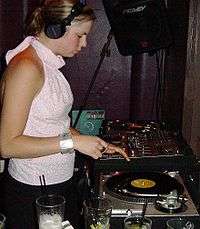
In Western popular music, women musicians have achieved great success in singing and songwriting roles, however, there are relatively few women DJs or turntablists. Part of this may stem from a general low percentage of women in audio technology-related jobs. A 2013 Sound on Sound article stated that there are "...few women in record production and sound engineering."[47] Ncube states that "[n]inety-five percent of music producers are male, and although there are female producers achieving great things in music, they are less well-known than their male counterparts."[47] The vast majority of students in music technology programs are male. In hip hop music, the low percentage of women DJs and turntablists may stem from the overall male domination of the entire hip hop music industry. Most of the top rappers, MCs, DJs, record producers and music executives are men. There are a small number of high-profile women, but they are rare.

In 2007 Mark Katz's article "Men, Women, and Turntables: Gender and the DJ Battle," stated that "very few women [do turntablism] battle[s]; the matter has been a topic of conversation among hip-hop DJs for years."[48] In 2010 Rebekah Farrugia states "the male-centricity of EDM culture" contributes to "a marginalisation of women in these [EDM] spaces." [49] While turntablism and broader DJ practices should not be conflated, Katz suggests use or lack of use of the turntable broadly by women across genres and disciplines is impacted upon by what he defines as "male technophilia."[48] Historian Ruth Oldenziel concurs in her writing on engineering with this idea of socialization as a central factor in the lack of engagement with technology. She explains: "an exclusive focus on women's supposed failure to enter the field … is insufficient for understanding how our stereotypical notions have come into being; it tends to put the burden of proof entirely on women and to blame them for their supposedly inadequate socialization, their lack of aspiration, and their want of masculine values. An equally challenging question is why and how boys have come to love things technical, how boys have historically been socialized as technophiles."[50]
Lucy Green has focused on gender in relation to musical performers and creators, and specifically on educational frameworks as they relate to both.[51] She suggests that women's alienation from "areas that have a strong technological tendency such as DJ-ing, sound engineering and producing" are "not necessarily about her dislike of these instruments but relates to the interrupting effect of their dominantly masculine delineations."[52] Despite this, women and girls do increasingly engage in turntable and DJ practices, individually[53] and collectively,[54] and "carve out spaces for themselves in EDM and DJ Culture".[49] A 2015 article cited a number of prominent female DJs: Hannah Wants, Ellen Allien, Miss Kittin, Monika Kruse, Nicole Moudaber, B.Traits, Magda, Nina Kraviz, Nervo, and Annie Mac.[55]
There are various projects dedicated to the promotion and support of these practices such as Female DJs London.[56] Some artists and collectives go beyond these practices to be more gender inclusive.[57] For example, Discwoman, a New York-based collective and booking agency, describe themselves as "representing and showcasing cis women, trans women and genderqueer talent."[58]
Photo gallery
 Tom Cosm at the decks at the Rainbow Serpent Festival in 2008
Tom Cosm at the decks at the Rainbow Serpent Festival in 2008 Jeff Mills, live with three Pioneer CDJs and a Roland TR-909 drum machine, 2007
Jeff Mills, live with three Pioneer CDJs and a Roland TR-909 drum machine, 2007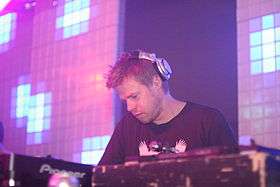 Trance DJ Ferry Corsten in Canada
Trance DJ Ferry Corsten in Canada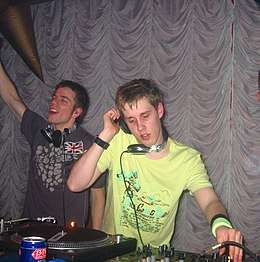
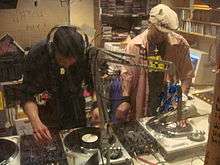 Two hip hop DJs creating new music by mixing tracks; DJ Hypnotize (left) and Baby Cee (right)
Two hip hop DJs creating new music by mixing tracks; DJ Hypnotize (left) and Baby Cee (right)
In film
- Berlin Calling – a German film about fictional DJ and producer Ickarus (Paul Kalkbrenner), who is struggling with drug abuse
- Speaking in Code – an American documentary film about techno artists Modeselektor, Wighnomy Brothers, Philip Sherburne, Monolake and David Day
- Kvadrat – a French and Russian documentary film about the realities of techno DJing, using the example of DJ Andrey Pushkarev
- It's All Gone Pete Tong – a fictional mockumentary Canadian movie about Frankie Wilde, a DJ who gradually becomes deaf due to drug abuse and an unhealthy lifestyle
- We Are Your Friends – an American fiction film about a college DJ trying to make it in the DJing scene with "one hit song", starring Zac Efron
- Scratch (2001 film) – a documentary about the hip-hop DJ and the 2000-era turntablist movement
- Tonkatsu DJ Agetarou – a Japanese anime, originally a manga, about a fictional character named Agetarou who aspires to be a DJ master with the help of his friends and mentor, Big Master Fry.
- 24 Hour Party People – about the UK music scene from the late 1970s to the "Madchester" scene of the late 1980s and early 1990s
See also
Notes
- ↑ How To Read A Crowd (And What Happens If You Don’t), Digital DJ Tips, 3 November 2017
- ↑ Red Bull 3Style
- ↑ Thorp, John (7 January 2014). "Resident DJs Are The Heroes Of Clubbing, And We Need To Show Them Love | Thump". Thump. Vice. Retrieved 2017-02-09.
- 1 2 Celikbas, Murat (2013-10-01). "What Is "Being A Resident DJ" ?". Digital DJ INFO. Retrieved 2017-02-09.
- ↑ "The Do's and Don'ts of Being a Weekly Resident DJ". Complex. 14 November 2013. Retrieved 2017-02-09.
- ↑ "DARIUS SYROSSIAN (BEST RESIDENT DJ)". DJMag.com. Retrieved 2017-02-09.
- ↑ "Resident DJ Mednas Dishes On Miami LIV-ing". Vibe. 2013-04-19. Retrieved 2017-02-09.
- ↑ Ncube, Dumisani. "The Monitor :: Variety Of Talent At Next Big EDM DJ". The Monitor. Retrieved 2017-02-09.
- ↑ Frankland, Becca (7 February 2017). "mUmU Liverpool 9th birthday review". Skiddle.com. Retrieved 2017-02-09.
- ↑ Robinson, Tyler (9 March 2016). "How to Become the Resident Dj At Your Local Nightclub". www.magneticmag.com. Retrieved 2017-02-09.
- ↑ Golden, Ean (2015-04-16). "How to Get a DJ Residency". DJ TechTools. Retrieved 2017-02-09.
- ↑ "5 clubs you need to visit before you die". www.redbull.com. Retrieved 2017-02-09.
- ↑ "Wynn Nightlife Announces 2017 Las Vegas Resident DJs". Billboard. Retrieved 2017-02-09.
- ↑ "Top 10 Resident DJs of all Time". DJBroadcast. Retrieved 2017-02-09.
- ↑ "10 Resident DJs Who Changed EDM". Billboard. Retrieved 2017-02-09.
- ↑ Stacy Zemon (24 July 2013). The Mobile DJ Handbook: How to Start & Run a Profitable Mobile Disc Jockey Service. Taylor & Francis. pp. 6–. ISBN 978-1-136-11734-3.
- ↑ Mark J. Butler (2014). Playing with Something that Runs: Technology, Improvisation, and Composition in DJ and Laptop Performance. Oxford University Press. pp. 111–. ISBN 978-0-19-539362-0.
- ↑ Shaquille O'Neal had a blast performing at an electronic music festival as 'DJ Diesel', USA Today Sports, 25 July 2016
- ↑ Minieri, Nick. "Bedroom DJ Woes: Why You're Not Getting Booked (And What To Do About It)". DJ Tech Tools. DJ TechTools. Retrieved 25 January 2018.
- ↑ GetAHeadphone (2016), Best DJ Headphones, retrieved 27 October 2016
- ↑ "Harmonic mixing: The Basics". Retrieved 29 December 2013.
- ↑ "DJ Mixes Remixes". Retrieved 29 December 2013.
- ↑ "Archived copy". Archived from the original on 15 August 2014. Retrieved 2014-04-08.
- ↑ Wendy Fonarow. Empire of Dirt: The Aesthetics and Rituals of British Indie Music. Wesleyan University Press; 10 July 2006. ISBN 978-0-8195-6811-3. p. 270–.
- ↑ Charles Kriel. How to DVJ: A Digital DJ Masterclass. CRC Press; 25 January 2013. ISBN 978-1-136-12270-5. p. 106–.
- ↑ Heath, Harold. "Crimes against DJing. What's the single worst sin a DJ can commit?". International DJ Magazine. International DJ Magazine. Retrieved 1 July 2017.
- ↑ Calvano, Jordan (11 May 2015). "This is the most fake DJ set you have ever seen". www.magneticmag.com. Magnetic Magazine. Retrieved 30 June 2017.
- ↑ "Justice Unplugged". URB. 18 November 2008. Archived from the original on 19 December 2008. Retrieved 19 December 2008.
- ↑ "Justice (don't) fake DJ set – (false) panic in technoland".
- ↑ Payne, Chris. "Disclosure Explains Their Unplugged Miming Performance in London". Billboard.com. Billboard. Retrieved 1 July 2017.
- ↑ Rohter, Larry (16 August 2010). "Museum Acquires Storied Trove of Performances by Jazz Greats". New York Times. Retrieved 30 October 2010.
- ↑ "OED Appeals". oed.com. Oxford English Dictionary. Retrieved 19 September 2016.
- ↑ "So You Want To Be A DJ? History". UF Interactive Media Lab. University of Florida. Retrieved 19 September 2016.
- 1 2 3 Michael Veal (2013), Dub: Soundscapes and Shattered Songs in Jamaican Reggae, pages 26-44, "Electronic Music in Jamaica", Wesleyan University Press
- 1 2 3 Nicholas Collins, Margaret Schedel, Scott Wilson (2013), Electronic Music: Cambridge Introductions to Music, page 20, Cambridge University Press
- 1 2 Brian Coleman, The Technics 1200 — Hammer Of The Gods, Medium
- ↑ The World of DJs and the Turntable Culture, page 43, Hal Leonard Corporation, 2003
- ↑ Billboard, 21 May 1977, page 140
- 1 2 3 Trevor Pinch, Karin Bijsterveld, The Oxford Handbook of Sound Studies, page 515, Oxford University Press
- ↑ "History of the Record Player Part II: The Rise and Fall". Reverb.com. Retrieved 5 June 2016.
- 1 2 Six Machines That Changed The Music World, Wired, May 2002
- 1 2 Neil Kulkarni (2015), The Periodic Table of HIP HOP, page 44, Random House
- 1 2 808 (documentary film)
- ↑ Vine, Richard (15 June 2011). "Tadao Kikumoto invents the Roland TB-303". The Guardian. Retrieved 9 July 2011.
- ↑ http://complex.com/music/2014/09/roland-tr-909-tracks/
- ↑ http://mixmag.net/feature/909-tracks-using-the-tr-909
- 1 2 Ncube, Rosina (September 2013). "Sounding Off: Why So Few Women In Audio?". Sound on Sound.
- 1 2 Katz, Mark (12 December 2007). "Men, Women, and Turntables: Gender and the DJ Battle". The Musical Quarterly. doi:10.1093/musqtl/gdm007.
- 1 2 Farrugia, Rebekah (2013). Beyond the Dance Floor: Female DJs, Technology and Electronic Dance Music Culture. University of Chicago Press. ISBN 978-1841505664.
- ↑ Oldenziel, Ruth A. (1997). "Boys and Their Toys: The Fisher Body Craftsman's Guild, 1930–1968, and the Making of a Male Technical Domain". Technology and Culture.
- ↑ Green, Lucy (2008). Music, Gender, Education. Cambridge University Press. ISBN 978-0521555227.
- ↑ "Music – GEA – Gender and Education Association". www.genderandeducation.com. Archived from the original on 3 March 2016. Retrieved 12 March 2016.
- ↑ "Female Turntablists on the Rise". BPMSUPREME TV. Retrieved 2016-03-12.
- ↑ "9 All-Female DJ Collectives You Need To Know Right Now". The FADER. Retrieved 2016-03-12.
- ↑ Robertson, Joel. "TOP 10: Female DJs". Festicket Magazine. Festicke Ltd. Retrieved 13 February 2018.
- ↑ "Enter". femaledjs.london. Archived from the original on 13 March 2016. Retrieved 12 March 2016.
- ↑ Rodgers, Tara (2010). Pink Noises: Women on Electronic Music and Sound. Duke University Press. ISBN 978-0822346739.
- ↑ "About – Discwoman". www.discwoman.com. Retrieved 2016-03-12.
References
- Assef, Claudia (2000). Todo DJ Já Sambou: A História do Disc-Jóquei no Brasil. São Paulo: Conrad Editora do Brasil. ISBN 85-87193-94-5.
- Brewster, Bill, and Frank Broughton (2000). Last Night a DJ Saved My Life: The History of the Disc Jockey. New York: Grove Press. ISBN 0-8021-3688-5 (North American edition). London: Headline. ISBN 0-7472-6230-6 (UK edition).
- Broughton, Frank, and Bill Brewster. How to DJ Right: The Art and Science of Playing Records. New York: Grove Press, 2003.
- Graudins, Charles A. How to Be a DJ. Boston: Course Technology PTR, 2004.
- Lawrence, Tim (2004). Love Saves the Day: A History of American Dance Music Culture, 1970–1979 . Duke University Press. ISBN 0-8223-3198-5.
- Miller, Paul D. a.k.a. DJ Spooky, Sound Unbound: Writings on DJ Culture and Electronic Music, MIT Press 2008. ISBN 0-262-63363-9 ISBN 978-0-262-63363-5.
- Poschardt, Ulf (1998). DJ Culture. London: Quartet Books. ISBN 0-7043-8098-6.
- Zemon, Stacy. The Mobile DJ Handbook: How to Start & Run a Profitable Mobile Disc Jockey Service, Second Edition. St. Louis: Focal Press, 2002
External links
| Wikiquote has quotations related to: Disc jockey |
| Wikimedia Commons has media related to Disc jockey. |